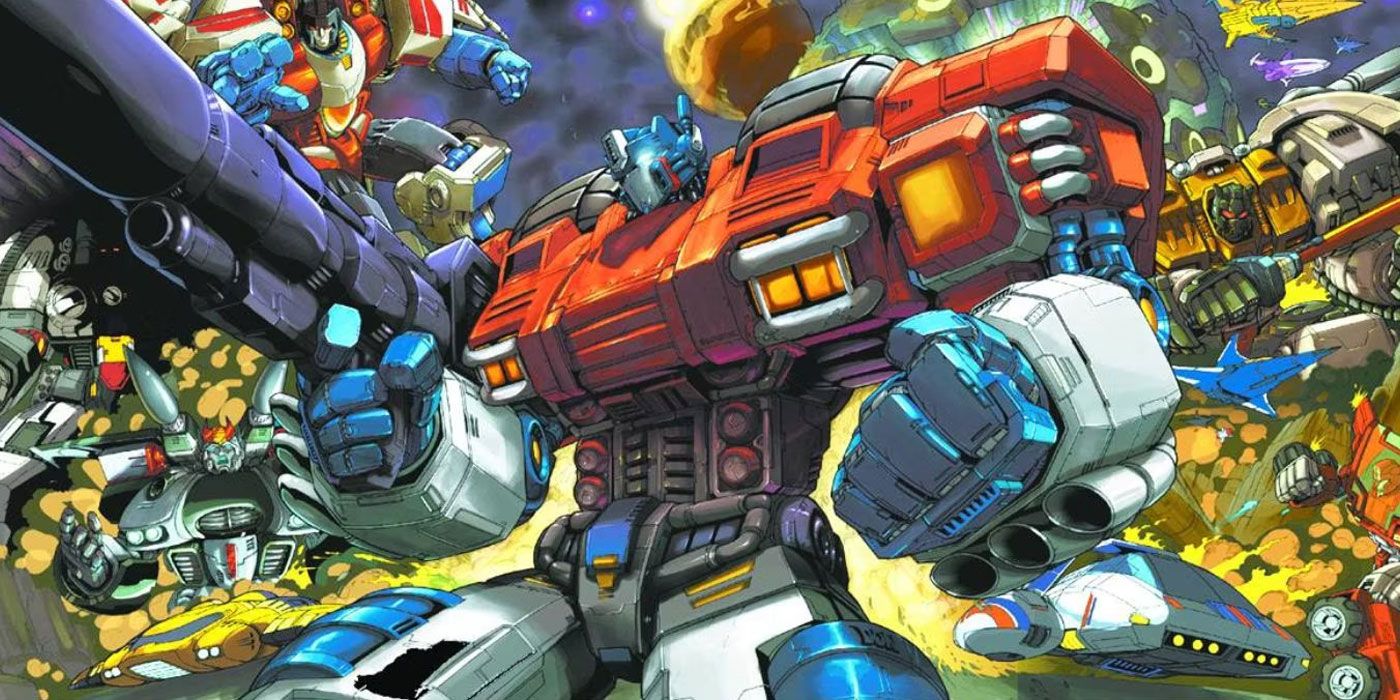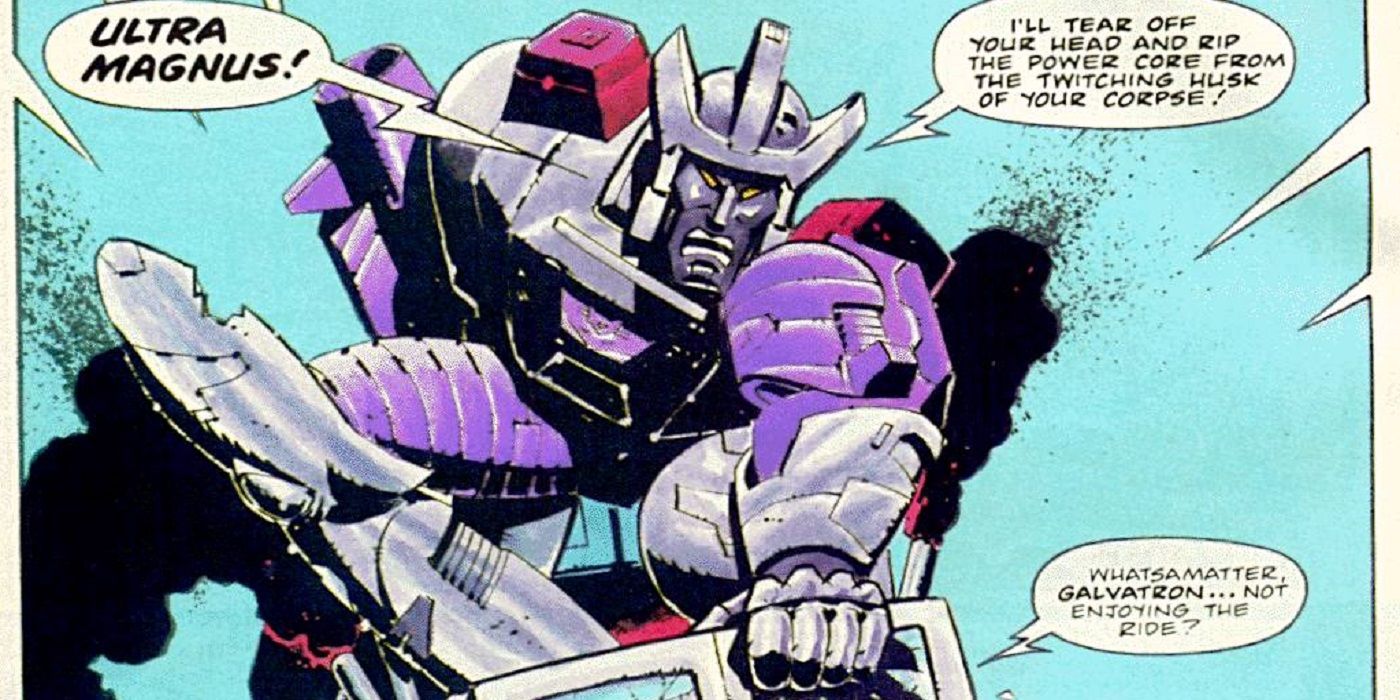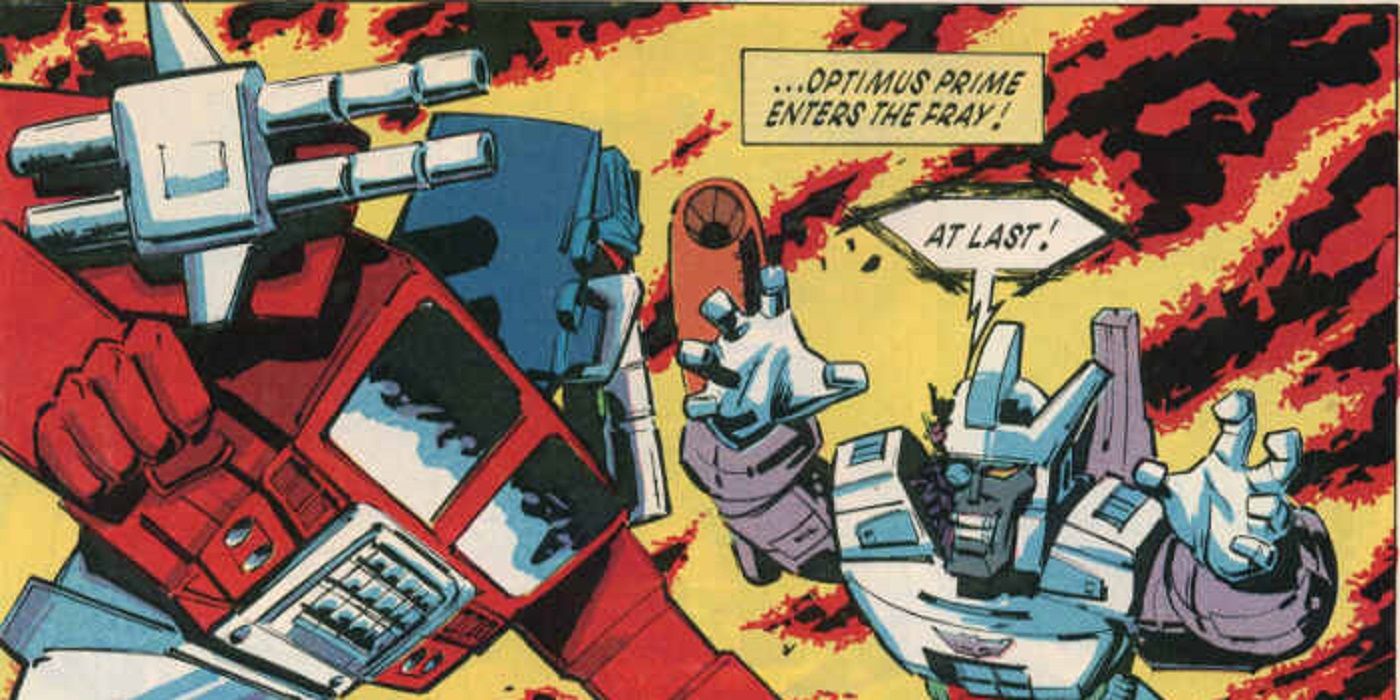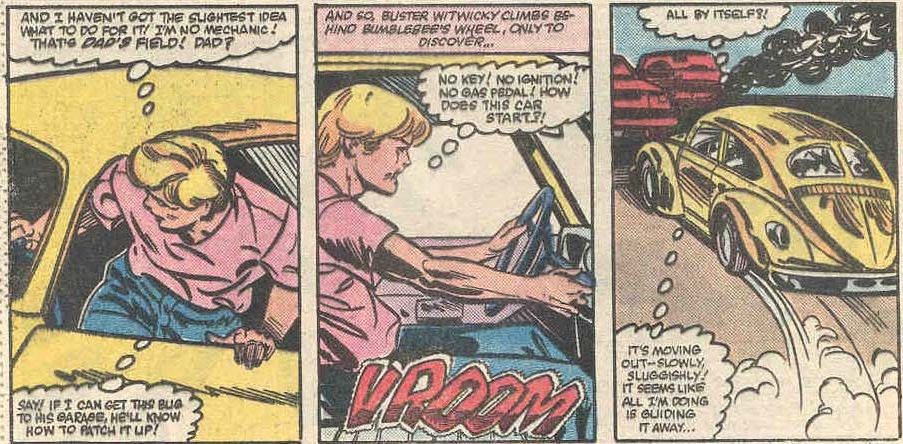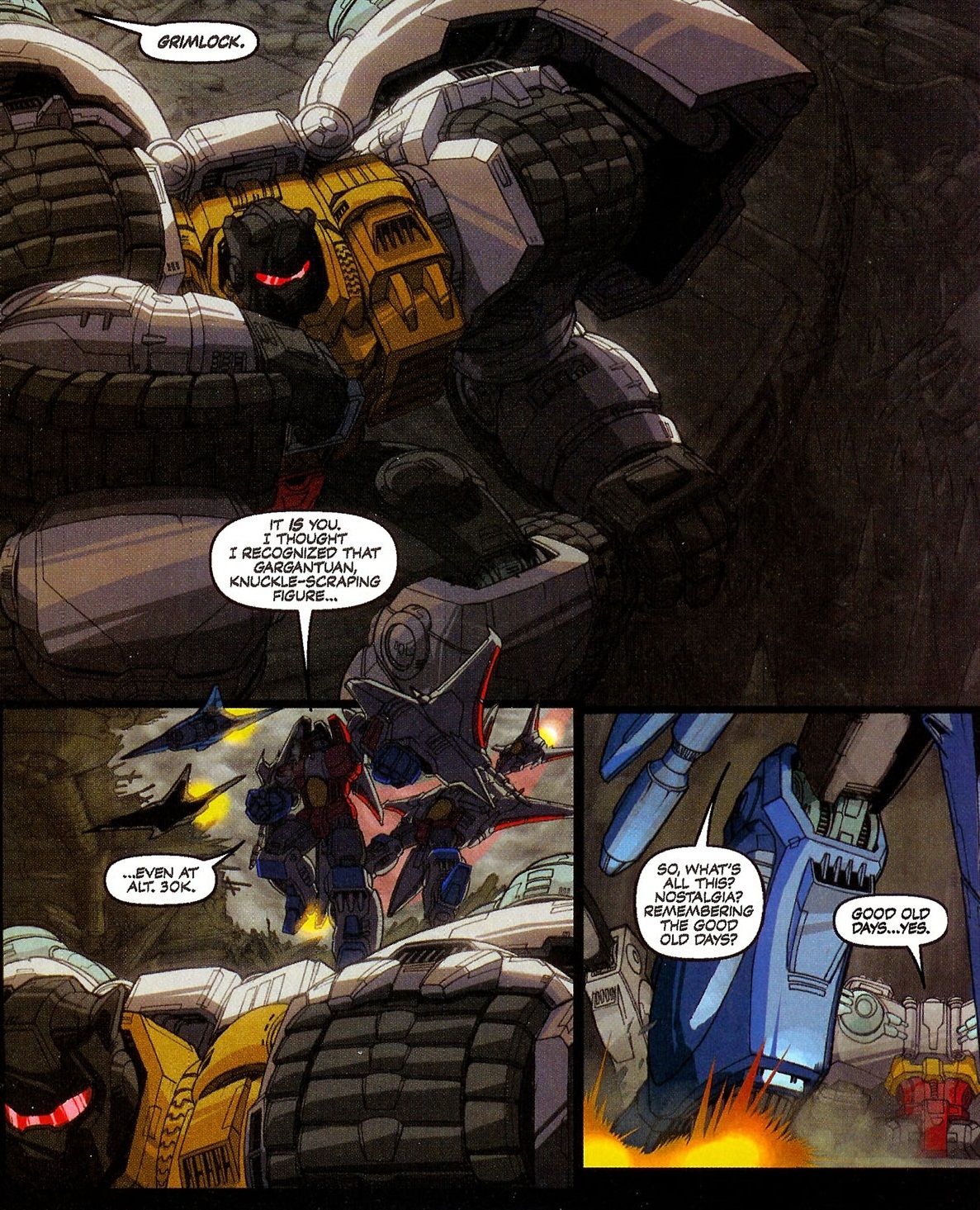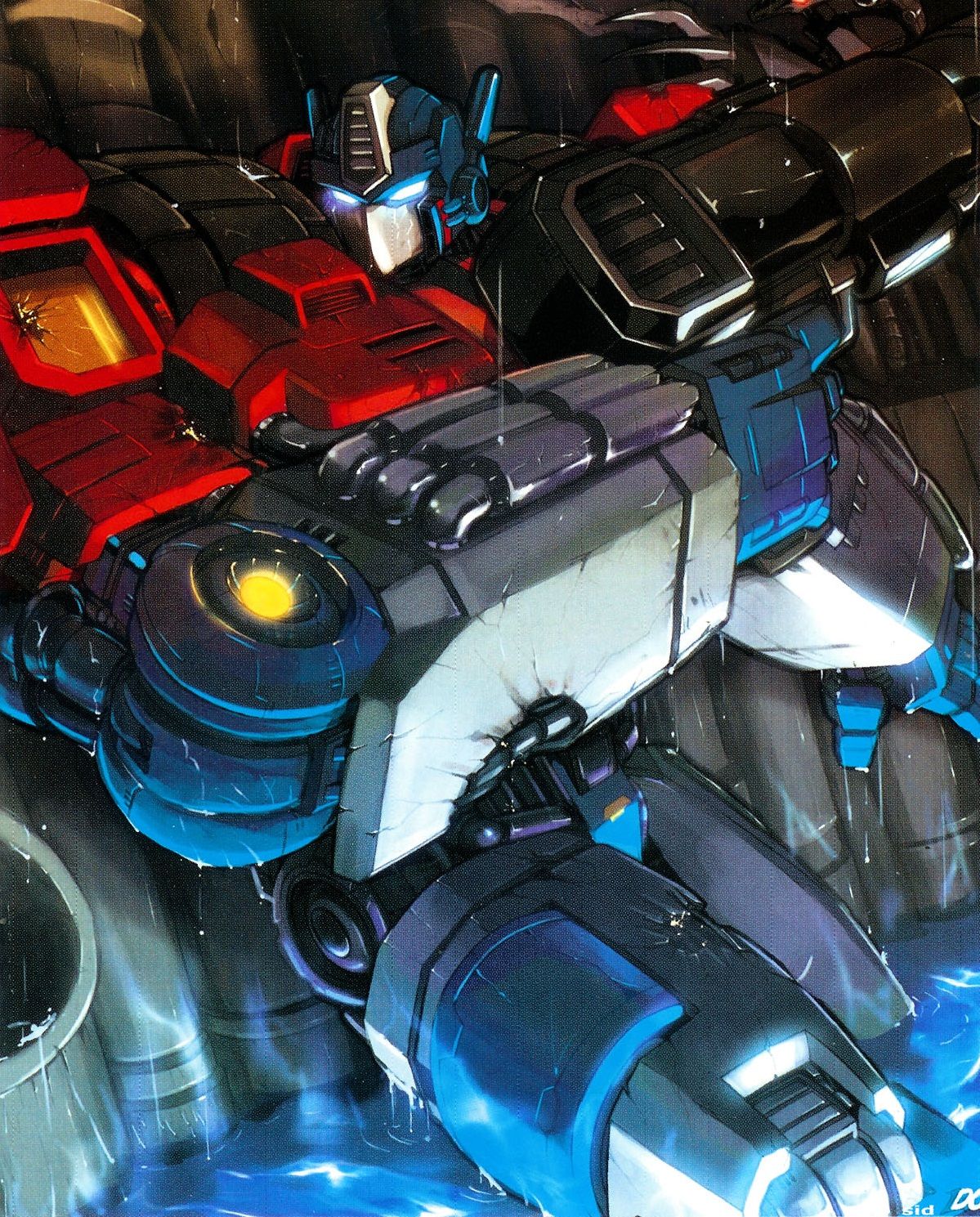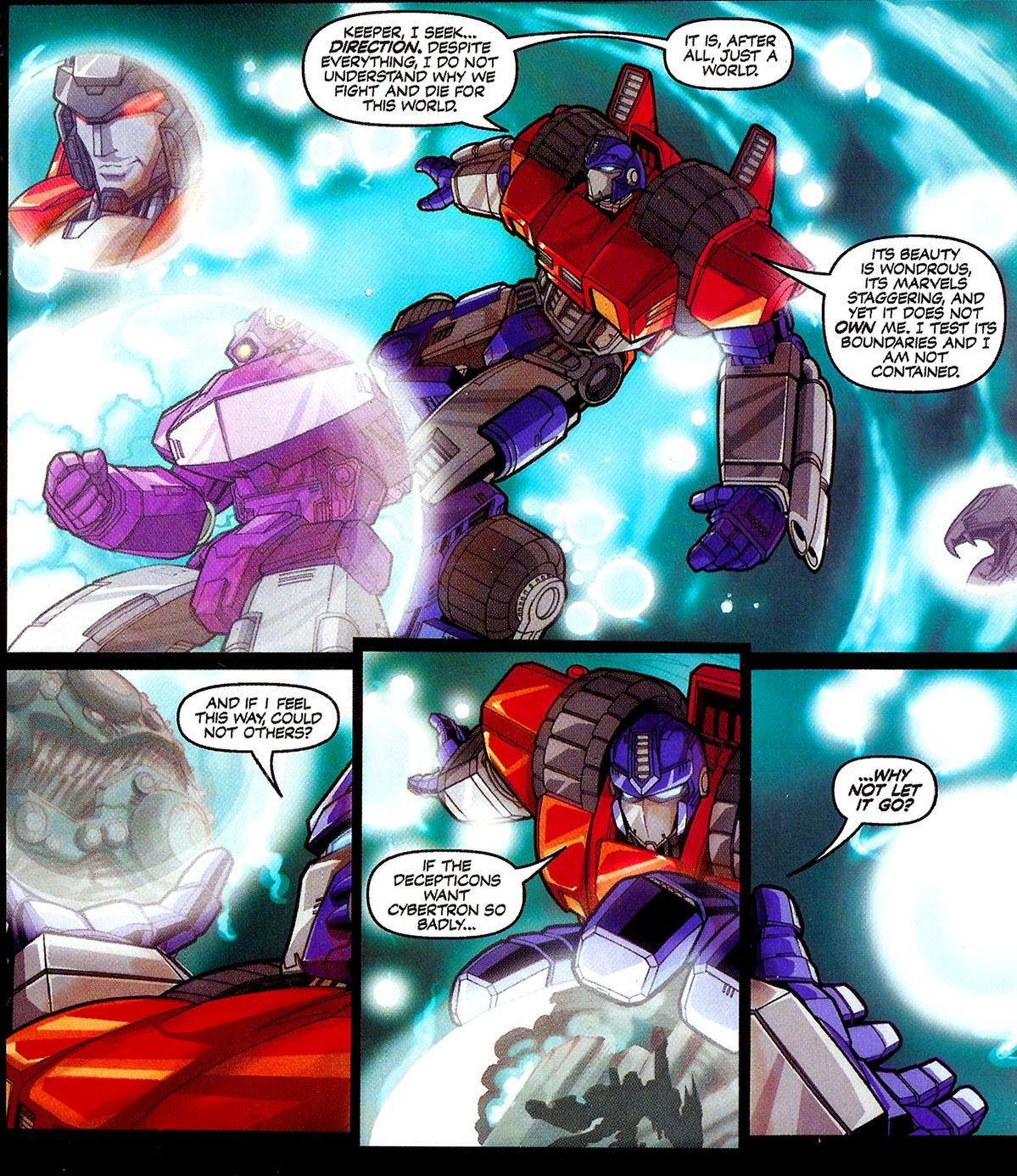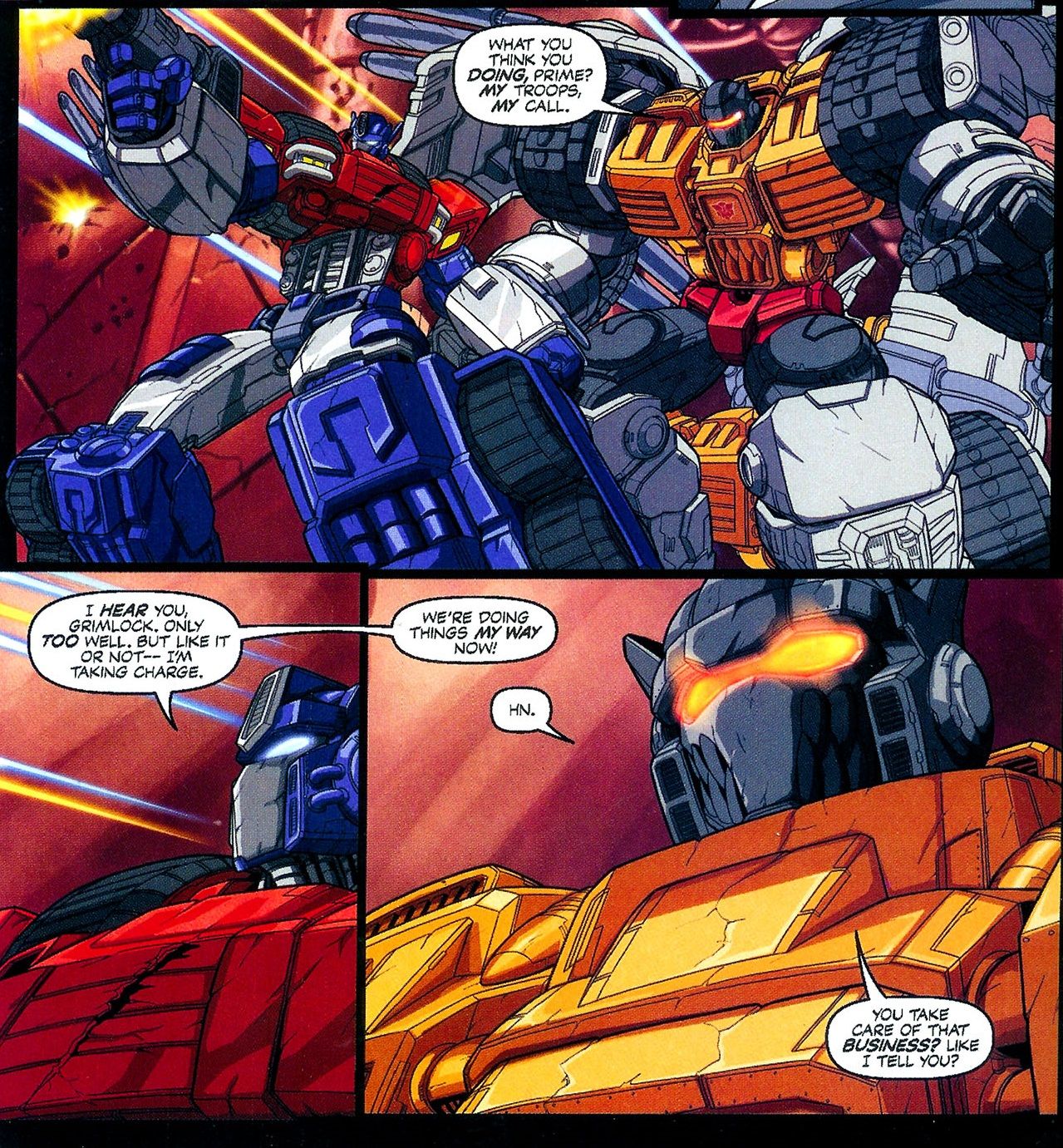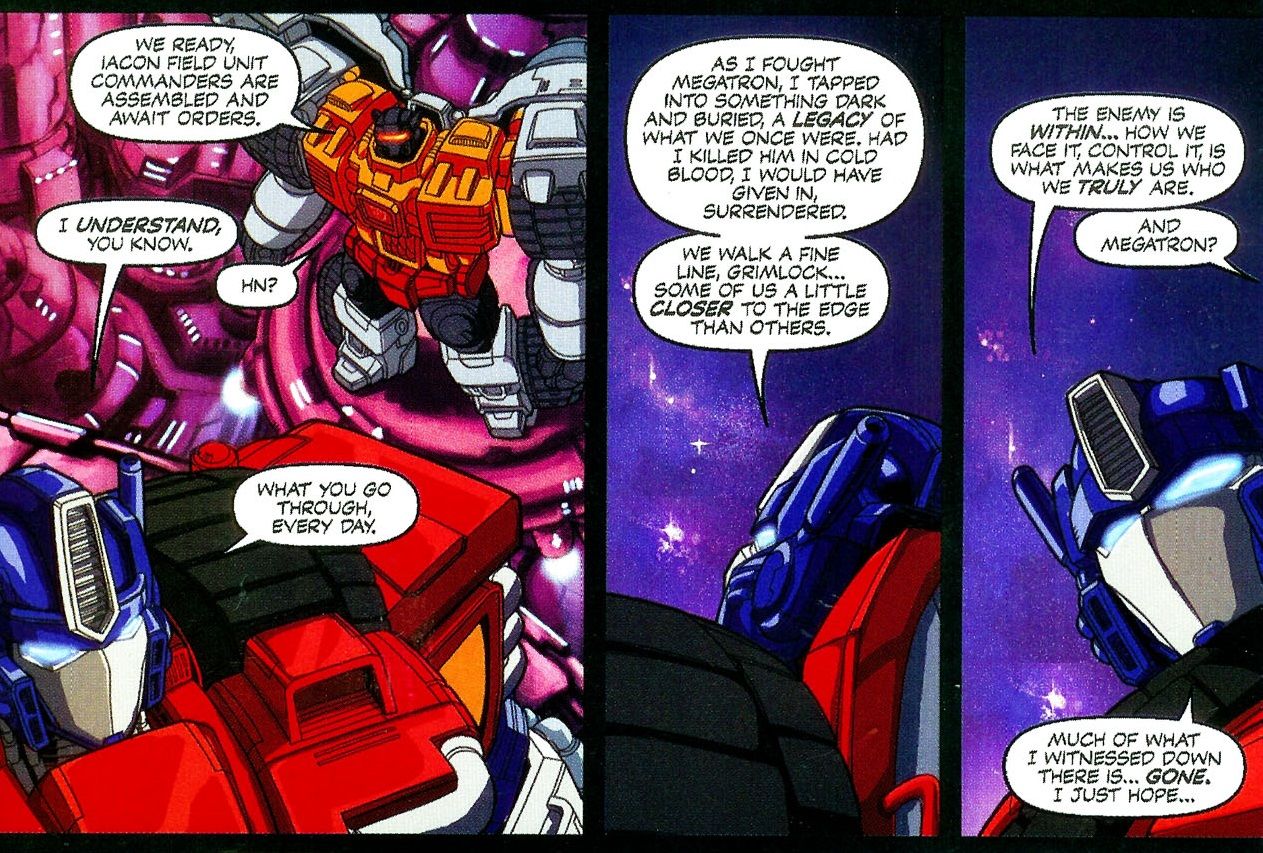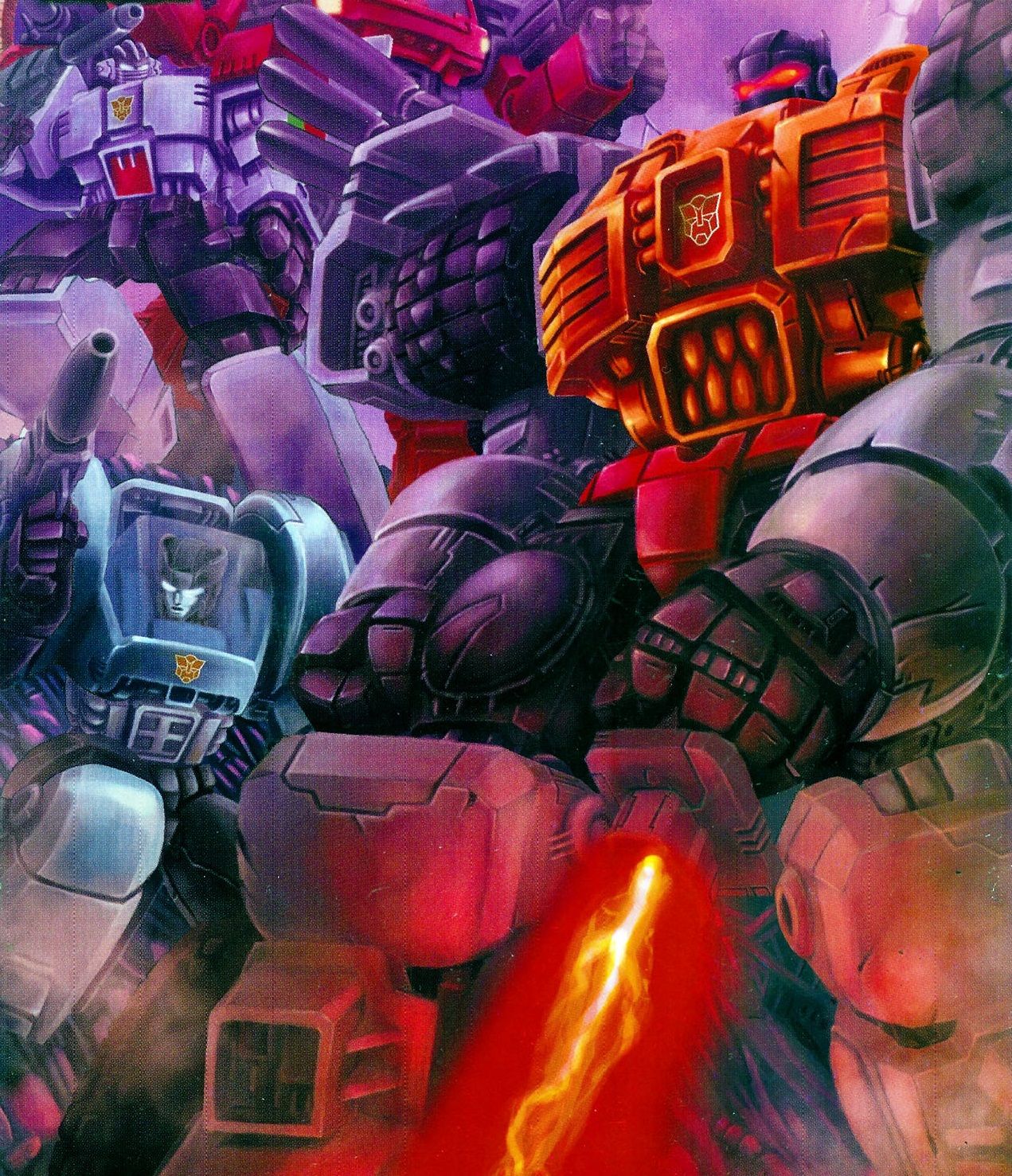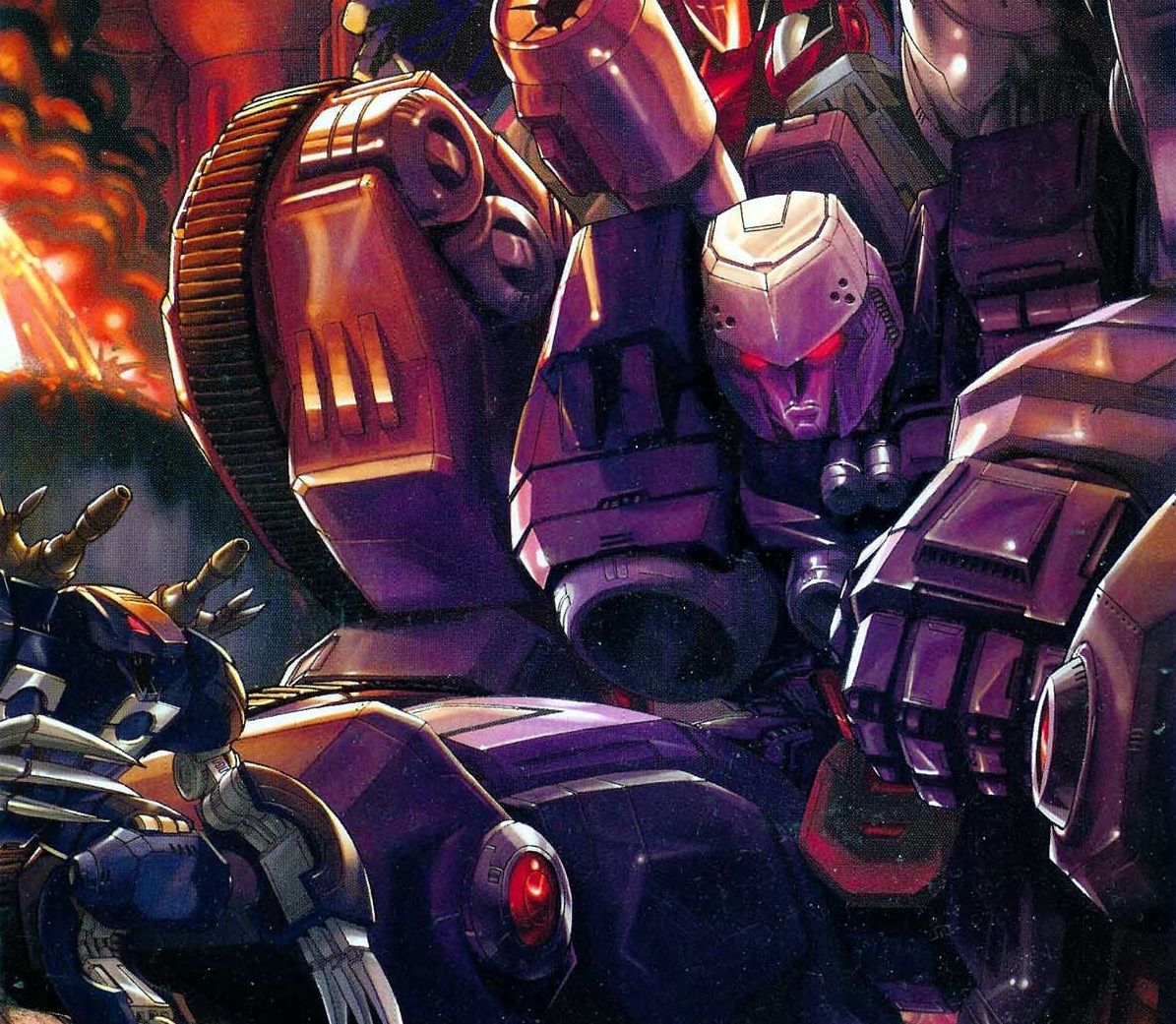Welcome to the 21st installment of Nostalgia Snake, a look at 2000s revivals of 1980s properties; revivals now so old they're also quite nostalgic. (Hence the snake of nostalgia eating itself.). This week, a fan-favorite Transformers creator is joined by a skilled fan-fic artist to create what might've been a record amount of Transformers fan service for one series. And if you have any suggestions for the future, let me hear them. Just contact me on Twitter.
While Dreamwave's 2002 relaunch of the Transformers property was a sales success, some diehard fans were irritated by Dreamwave's decision to keep the production "in house," with the studio providing not only art and colors but also stories. The initial miniseries was written by Chris Sarracini, with Dreamwave editor James McDonough stepping in to plot the sequel series under the pen name of Brad Mick.
Even if most readers were genuinely impressed with Dreamwave's top-notch production values and anime-inspired art, diehards argued for a return of the most celebrated writer from the original Transformers comic. And while Bob Budiansky, who wrote most of the early issues and provided character profiles that defined the classic Autobots and Decepticons, deserves his place in Transformers history, the dedicated fanbase insisted on the return of his replacement, Simon Furman.
The Fans Demanded It
Today the most prolific writer of Transformers material, Furman's association with the franchise began at Marvel UK, where he worked as assistant editor, then editor, then writer of the material created specifically for British audiences. (With the book released weekly overseas, several pages of original material had to be created to supplement reprints of the monthly American series.) Even though Furman was typically forced to craft stories set between issues of the American reprints, Furman's material developed a cult following within the fandom. In contrast to the American comics, Furman's stories tended to deal with more complex themes, exploring heady science fiction concepts and characterizations that complicated the simplistic notion of pure Autobots and malevolent Decepticons.
When tasked with creating tie-in stories to 1986's Transformers: The Movie (even though the film had nothing to do with the existing comics continuity), Furman not only crafted some entertaining time-travel tales involving the next generation of Transformers, but he also developed an elaborate origin for the Autobots, Decepticons, their home planet Cybertron, and the planet-eater Unicron. The mythology conceived by Furman in only a few issues of the Marvel UK comic still serves as the spine for much of the existing lore today.
When Bob Budiansky chose to step away from the American Transformers series, he suggested Furman as his replacement based on Furman's knowledge of the canon and the quality of his work for Marvel UK. Furman incorporated several aspects of his stories into the American series and brought along artist Geoff Senior from the UK title, who gave the Transformers a rougher, more dangerous look. Even though Transformers was dwindling as a franchise at this point, sales of the American comic increased shortly after Furman took the reins, and he's generally regarded as the spark that enabled the book to stay alive for a few more years.
In 1993, Furman returned for Marvel's short-lived Transformers: Generation 2 comic, a series that arrived far too early for the typical twenty-year cycle of nostalgia to hit. By 2002, however, '80s kids once enamored with the Robots in Disguise were adults with disposable income, frequenting comic shops and surfing the nascent internet message boards. When new Transformers stories arrived without Furman's involvement, they demanded the return of their favorite writer.
No. Kid. Sidekicks.
Joining Furman would be Don Figueroa, an indie artist who was developing a following with his online Transformers fan-fiction. In case anyone was hazy on the "for the fans" concept, a preview special for the miniseries had text pieces from both Furman and Figueroa expounding upon their devotion to this property and their hope that fans would accept their attempt at creating a "best of" version of the Transformers' origins, pulling from various sources. (Oddly, neither stated a desire to sip on "Fanboy Tears" if the audience didn't respond to their story.)
The remit for their miniseries, The War Within, was to expound upon the early days of the Autobot/Decepticon war, years before they crashed onto Earth. While previous episodes of the animated series and some issues of the comic had glimpses of this era, the results were typically disappointing.
As many fans complained, the characters' Cybertronian looks still maintained elements of Earth vehicles, which didn't make sense, as the robots had yet to adopt Earth forms. Truthfully, the Transformers' "prequel" versions never looked quite right because these stories weren't the franchise's real focus. The alien environment was backstory and not an element the artists had much time to develop properly. The focal point had always been getting the Autobots and Decepticons to Earth as quickly as possible to feature their transforming vehicle modes.
Figueroa devoted himself to re-imagining the cast and removing earthly influences from their designs. His goal was to keep the characters recognizable but also to create logical and practical alt-modes that made sense for Cybertron. This concept is nothing new today -- Hasbro now releases Cybertronian versions of the cast as action figures, and a trilogy of successful videogames in the 2000s from High Moon Studios were set as prequels -- but War Within was unique for its time. Fan response to Figueroa's redesigns was so positive Hasbro even released a line of toys based on his work in their Titanium Series line.
Another element of the series was sure to please a vocal segment of Transformers fandom -- as the story is set before the Autobot and Decepticon factions' earthly arrival, the number of humans in the story totals to around zero. Traditionally, this would be considered too "niche," depriving the audience of recognizable human faces and identification figures. (It's not a coincidence that Transformers stories created for audiences across the globe tend to feature plucky teens befriending the Autobots before the end of Act One.) However, it's a long-time wish come true for an element of the fandom.
Set during the early days of Cybertron's Great War, Megatron is a ferocious rebellion commander, leading his armies in a brutal battle against the Autobots. When Sentinel Prime falls in battle, an unnamed data entry bot is unexpectedly named by the Autobot High Council to replace him. Their new leader Optimus Prime faces skepticism, especially from the irritable one-time gladiator Grimlock, and nearly inspires an Autobot insurrection when he makes a command decision to surrender Cybertron to the Decepticons.
Megatron, meanwhile, swats away Starscream's disloyalty as his focus turns to a secret hiding beneath Cybertron's surface. If he steals the Matrix of Leadership from Prime's chest, he believes its energy with power Cybertron and transform the planet into an orbital dreadnought, enabling Megatron to conquer foreign galaxies.
Grimlock Asks…"Hurm?"
Perhaps the most controversial decision in the early Dreamwave comics was the sudden heel turn of Dinobot leader Grimlock against the Autobots -- a move the creators of the follow-up miniseries swiftly backed away from. The heel turn was unpopular, but it's not impossible to guess why the creators made this call. In the original animated series, Grimlock was often portrayed as a rebellious toddler, and in the Marvel comic, he was arrogantly and openly disdainful of Optimus Prime's leadership.
Working with the new "best of" Dreamwave continuity, Furman adds some depth to Grimlock, providing motivation for his current-day characterization. War Within establishes Grimlock as a veteran of the Cybertronian cage-fighting arenas and a one-time ally of the Decepticons. Though he never truly felt as if he belonged on either side, the Grimlock we meet here is dedicated to the Autobot cause and responds violently to Starscream's offer to rejoin the Decepticons.
Increasingly frustrated with the Council of Ancients and dismissive of a new file clerk commander, Grimlock toys with the idea of stealing leadership from Optimus Prime for much of the series. However, when he realizes the severity of Megatron's plan, he finds himself aligned with Prime in the bowels of Cybertron.
Even though Prime doesn't follow Grimlock's advice to fatally deal with Megatron, he does earn the future Dinobot's respect when Prime survives his fight with Megatron and asserts command of Grimlock's forces in a decisive battle against the Decepticons. Having gained new perspective on the future, Prime's rededicated to fighting for Cybertron, delaying Grimlock's mutinous dreams for at least a few decades.
When attempting to merge the two conflicting 1980s portrayals of Grimlock (a buffoon with a Captain Caveman speech pattern in the animation, but far less ridiculous in the comics), Furman is forced to hit an odd balance. Grimlock typically uses "Me" instead of "I," but Furman portrays Grimlock as distant and taciturn in most scenes. In fact, he ends up with an odd staccato speech pattern reminiscent of Rorschach's in Watchmen! He even has "hnn" grunts that sound like Rorschach's patented "hurm." In one sequence, Grimlock speaks solely in one-syllable Rorschach-esque grunts, hinting that Furman wasn't doing this by accident.
For Diehards Only?
A detailed listing of the series' continuity shout-outs and tributes to toys, comics, and animation could go on forever. War Within does more than pay homage to the past, however. The series makes its own contributions to Transformers lore.
The concept of Megatron once competing in gladiator games was an obscure bit of Marvel UK trivia, but since War Within, it's become an essential part of his origin in various reboots. War Within is also the first official story to use the term "Seekers" for Decepticon jets. This was once only internet lingo amongst diehard fans, with hazy origins going back to the 1984 JC Penney Christmas catalog. Outside of Transformers mythology, War Within is an early example of internet culture influencing printed media and corporate gatekeepers expressing appreciation for fan culture.
So, all that said, does the series have any appeal to casual readers? The production values are as impressive as most Dreamwave releases of the era. The color palette successfully channels classic anime, and the art team of penciler Don Figueroa and inker Elaine To is reminiscent of Joe Madureira and Tim Townsend's groundbreaking Uncanny X-Men work. The storytelling is occasionally choppy, however, and the transformation sequences would've benefited greatly from having some type of "ghosting" effect on the "in-between" sequences. These pages read as if one Transformer is standing in the foreground while two or three odd-looking Transformers with the same color scheme pose awkwardly behind him.
Furman's story has well-considered character arcs and intriguing stakes for the cast. It's also so heavily steeped in the lore, so concerned with setting up the future and showing off as many characters as possible, that readers run the risk of getting lost. If this had been the initial Dreamwave Transformers release, at least some percentage of those casual fans who simply had warm memories of the cartoon might've dropped off quickly. Still, this was never intended as Dreamwave's main Transformers product. The remit was to create a tribute to those dedicated to the lore, and in that regard, War Within more than delivered.

